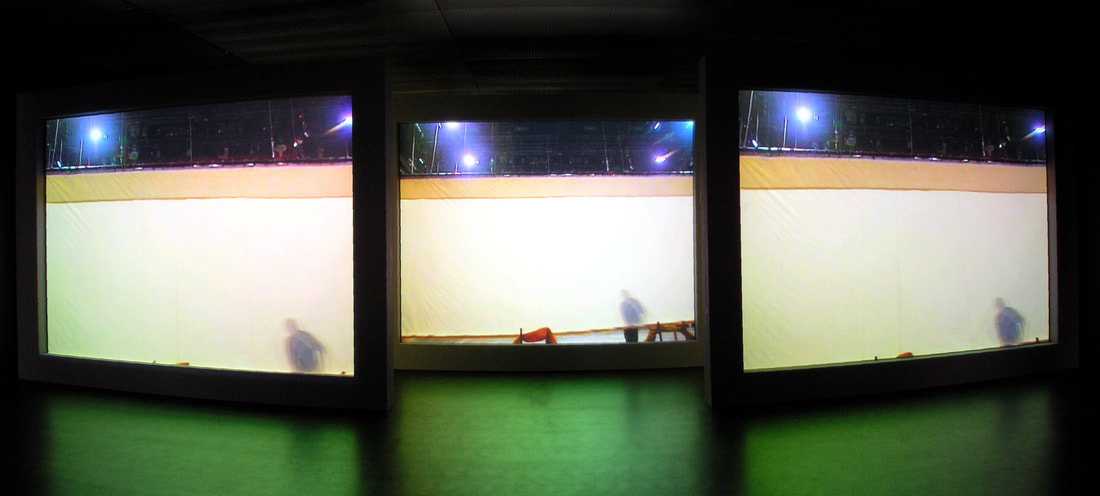Parallel Worlds 2004.
|
In Parallel Worlds, a solo exhibiton at Lentos Kunstmuseum]…Oechsler exhibits two corresponding video installations Schauspiel (2003) and Ghost (2004). Both works are based on films shot at Schauspiel Staatstheater Stuttgart. Oechsler is interested in the preparation work, which takes place in the theatre before the actual play begins: the technically elaborate and labour intensive set-up of the stage set. The construction of the space of illusion becomes the real spectacle.
|
Commissioned and produced by Site Gallery, Sheffield for Parallel States, Lentos Kunstmuseum Linz, Austria, in co-operation with Schauspiel Staatstheater Stuttgart, Germany.
Financially supported by Site Gallery, Sheffield, Akademie Schloss Solitude, Stuttgart, Germany, Mfg Filmfoederung, Baden Wuerttemberg, Stuttgart, Germany, The Northern Media School, Sheffield Hallam University, Sheffield. |
|
|
Schauspiel 2003 Installation view: Parallel States , Lentos Kunstmuseum Linz, Austria, 2004. Three channel video projection installation Duration sequence: 21” Synchronised looped playback Exhibition format DVD |
|
“Oechsler takes the preparations for a theatrical presentation and turns them into a ‘Schauspiel’ that is itself film. The stage is one of its dimensions, the screen is the other, and between the two the work is made up of what is filmed, how it is filmed and what it then becomes when projected onto three screens in a space one walks into. When a backdrop goes up on all three projection screens, they inevitably block both vision and space, and even the finished inclined stage floor is never just a flat surface to play on, but also a screen folded flat, supporting action and projecting towards the audience. In this double framing the work itself generates its own kind of production.
All the footage used comes from closely following the setting-up of a stage, but its very structure defies the coherence and linearity of that process. There are close-ups and panning shots, more and more machinery disappears in the process, elements, operations and operators are shown in all their |
clarity, but they never add up. Completion happens, and there is an inclined stage platform there at the end where there was none before, but this is precisely the end, not the beginning of the work, and relevant only in terms of this progress.”
“Setting a stage is a process of homogenising space and creating an illusion of coherence. Focusing on the process of this putting together, on the arrangements and movements of stage apparatus and crew, Schauspiel constitutes from these very elements, and in itself, a fundamentally mobile type of reality. Things are neither really assembled nor taken apart or removed; the focus of the work is on the continual transformation of space.” (Excerpt from the Essay “Parallel Oblique and Overlapping” by Edgar Schmitz, artist, writer, researcher at Goldsmiths College, London). |
|
|
Ibsen - Brand 2003
Series of four C-type photographs Dimensions: ca. 56 x 38 cm Edition of 10 Plus 2 AP The play Brand was staged at the Staatstheater Stuttgart, Germany and became the subject of the production of Schauspiel 2003 a three-screen video installation produced during a residency at Schloss Akademie Solitude. The stage design and production were exceptionally minimal with a white stage floor reaching forward into the auditorium and extending back stage whilst at times being elevated to a 45 degree angle. The minimal stage set was complimented by a scenography that consisted of a series of lighting phases which were reminiscent of natural atmospheres such as sunsets and sunrise. Hence the photographs were conceived in reference to abstract and minimal painting. Brand is a play by the Norwegian playwright Henrik Ibsen. It is a verse tragedy, written in 1865 and first performed in Stockholm, Sweden on 24 March 1867. |
|
|
Ghost 2005
Single channel video projection installation Duration ca.: 3 hrs Digital hard drive Silent Screen material, aluminium frame, PVC flooring Produced in co-operation with Schauspiel Staatstheater Stuttgart, Germany. Commissioned by Lentos Kunstmuseum, Linz, Austria. |
|
In Ghost a single-channel projection is placed in relation to the architectural space of the gallery and the bodies of the viewers through a spatial marking. Although recorded, moving images of the same processes are involved in both cases, there is a crucial difference: Schauspiel offers several perspectives of a seemingly "authentic" view – which actually does not exist, due to the specifications of camera techniques and direction of the filming – that is cleverly edited and synchronized, whereas
|
Ghost shows three chronological hours of filming with a single night-vision camera. With the parallel placement of these two recording techniques, Oechsler demonstrates that every recorded image is a conscious construction of meaning through the choice of techniques, the framing, the perspective, the material.
Excerpt from the catalogue Parallel Worlds, introduction by Stella Rollig, Director, Lentos Kunstmuseum Linz, Austria, 2005) |
|
|
Schauspiel Staatstheater 2002
Series of five c-type photographs Dimensions: 58 x 44 cm Edition of 10 + 2 AP |
